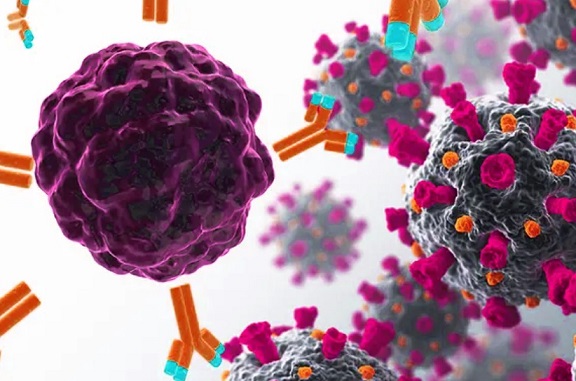Large Scale Study Reveals Which Cancer Types Are Most Vulnerable to COVID-19 Death
Nikhil Prasad Fact checked by:Thailand Medical News Team May 06, 2025 7 months, 2 weeks, 4 days, 5 hours, 45 minutes ago
Medical News: A new large-scale population-based study has unveiled alarming differences in the risk of COVID-19 death across various cancer types, showing that some cancer patients are far more vulnerable than others. The research was conducted by scientists from Shandong Cancer Hospital and Institute and Shandong First Medical University, in collaboration with the Laboratory of Molecular Cardiology at The First Affiliated Hospital of Shantou University Medical College and the Department of Radiation Oncology at Xinjiang Medical University.
 Large Scale Study Reveals Which Cancer Types Are Most Vulnerable to COVID-19 Death
Large Scale Study Reveals Which Cancer Types Are Most Vulnerable to COVID-19 Death
Using data from over 237,000 cancer patients listed in the US-based SEER database, researchers meticulously calculated COVID-19 mortality rates across different cancer types. This
Medical News report highlights how certain cancers, such as chronic lymphocytic leukaemia (CLL) and prostate cancer, were linked to the highest COVID-19 death rates, while others, like lung and bronchus cancer, surprisingly showed a lower death risk despite involving the respiratory system.
Shocking COVID-19 Death Rates in Cancer Patients
According to the study, about 5.3% of all cancer patients died due to COVID-19 in 2020. Notably, patients with chronic lymphocytic leukaemia faced the highest proportion of COVID-19 deaths (11%), followed by prostate cancer (9.5%) and thyroid cancer (7.8%). In stark contrast, lung and bronchus cancer patients showed a much lower rate of COVID-19 deaths at only 2.9%, even though these cancers affect the lungs, the primary site attacked by the virus.
The study also identified other cancers with elevated COVID-19 death risks, including multiple myeloma, bladder cancer, non-Hodgkin lymphoma, breast cancer, and colon cancer. Interestingly, patients with breast and prostate cancers, which are generally slow-growing and often treatable, had higher COVID-19 mortality rates, potentially due to treatment delays during the pandemic.
Years Since Diagnosis Matter More Than You Think
One of the most surprising findings was that the number of years since a patient’s cancer diagnosis played a major role in predicting COVID-19 death. The longer it had been since diagnosis, the higher the risk became. For example, patients diagnosed more than 15 years ago had over twice the risk of COVID-19 death compared to those diagnosed within five years.
Researchers theorize that long-term survivors may underestimate their vulnerability to infection, leading to fewer precautions and reduced immunity over time. Moreover, they may have more accumulated health issues, making them more susceptible to severe COVID-19 complications.
Treatment Not Linked to Higher COVID-19 Deaths
Contrary to earlier fears, receiving chemotherapy, radiotherapy, or surgery did not significantly increase the risk of dying from COVID-19. This finding offers some relief and suggests that continuing necessary cancer treatments during the pandemic may not pose the added threat it was
once believed to.
Age and sex also played roles. Patients aged 60–80 were at highest risk of COVID-19 death, while males had slightly higher mortality rates compared to females. Racial disparities were also noted, with white patients making up the majority of COVID-19 deaths, though Black patients often experienced worse outcomes due to healthcare access disparities.
Haematological Cancers Carry the Highest Risk
Blood cancers such as CLL, Hodgkin lymphoma, and myeloma were consistently associated with higher COVID-19 mortality. These cancers typically weaken the immune system, either by their nature or through treatments that reduce immune cell function. Patients with CLL were especially vulnerable, often experiencing poor outcomes and shorter survival after infection.
Researchers urge clinicians to treat CLL and other blood cancer patients as high-priority individuals when it comes to COVID-19 protection, including vaccinations, boosters, antiviral therapies, and strict infection control.
Conclusions
This study offers critical insights into how different types of cancer affect a patient’s risk of dying from COVID-19. It found that haematological cancers like CLL pose the highest threat, while cancers like lung and bronchus, despite involving the lungs, surprisingly show lower COVID-19 death rates. Equally important is the discovery that patients who were diagnosed more than a decade ago face a significantly increased risk of death, likely due to accumulated health issues or decreased vigilance. These findings emphasize the urgent need for tailored preventive strategies and ongoing risk assessments in cancer care during and beyond the COVID-19 era.
The study findings were published in the peer-reviewed Journal of Global Health.
https://jogh.org/2025/jogh-15-04046
For the latest COVID-19 News, keep on logging to Thailand
Medical News.
Read Also:
https://www.thailandmedical.news/news/canadian-scientists-warn-that-those-with-existing-neurological-conditions-have-higher-risk-of-dying-upon-infection-with-sars-cov-2
https://www.thailandmedical.news/news/slovenian-study-finds-that-higher-pulmonary-pressure-linked-to-long-term-death-risk-in-elderly-severe-covid-19-patients
https://www.thailandmedical.news/news/insurance-industry-warns-that-covid-19-is-still-killing-more-than-we-realize-and-excess-death-rates-might-remain-high-until-2033
https://www.thailandmedical.news/articles/coronavirus
https://www.thailandmedical.news/pages/thailand_doctors_listings
